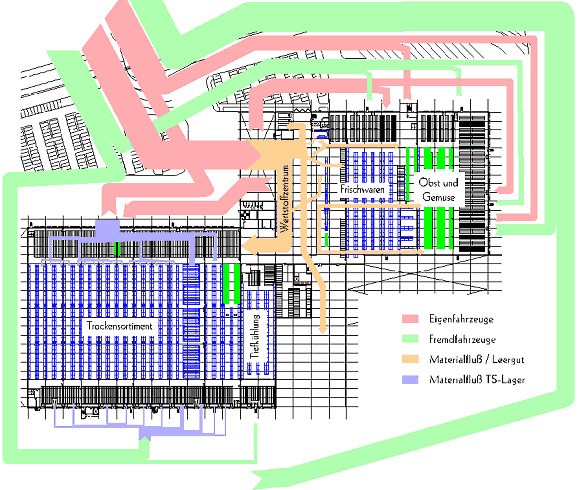Warehouse and material flow simulation and material flow planning are used to virtually design and optimise logistics sub-processes. We simulate processes from goods receipt to inspection, storage, transport to delivery or goods issue.
There are many approaches to cost savings in material flow, from the use of transport and conveying aids, standardised containers and loading units to the automation of internal storage and transport processes. External logistics must also be considered.
Warehouse and material flow simulation in practice
In the warehouse and material flow simulation, a layout is determined based on the most economical system solution. A material flow concept is developed to meet the following requirements:
- Optimised internal and external processes
- Optimal use of capacity
- Easy expansion
- Ideal use of space
These criteria and requirements are sometimes in competition with each other, so the optimisation approach mostly evaluates them.

Use of warehouse and material flow simulation in logistics
New logistics and production systems are tested for throughput, sizing and lead times using simulation models. Critical performance limits, disruptions, staffing requirements and other planning parameters can be evaluated. Warehouse and material flow simulation allows different system alternatives to be viewed, evaluated and compared independently. Based on pre-defined criteria, a ranking of the simulation variants is generated, in which target combinations with different priorities are analysed. ORGAPLAN puts your logistics to the test and develops sustainable concepts for increasing efficiency.
Ingo Schalow
Don‘t hesitate. We look forward to seeing you!
+49 (0) 4102-66780
ingo.schalow@orgaplan.net

Simulation of existing equipment and systems
Existing systems are realistically mapped and optimised within the simulation model. For example, using a different control strategy can lead to higher throughput without having to upgrade the system technology on the hardware side.
Modelling during design
Simulation at the design stage: A common mistake is to plan the building first and then think about the material flow. After Fergit has been created, complex conveyor technology for pallets or containers is planned into the building layout, the scope of which could have been significantly reduced if the material flow had been carefully planned.
The more complex the planning processes, the more difficult it is to generate reliable results. Once the limit of predictability has been reached, the only option is to simulate these processes in a dynamic material flow simulation.
Warehouse and material flow simulation is used to optimise and safeguard complex processes in complex system concepts. Material flow simulation can be used to
- Identify bottlenecks in the material flow
- Optimise processes and improve resource utilisation
- Determine system dimensions such as B. Goods buffer optimally
- Minimise risks through early review of planned concepts
The result is a range of system solutions that give you the planning certainty you need to optimise your internal material flow.